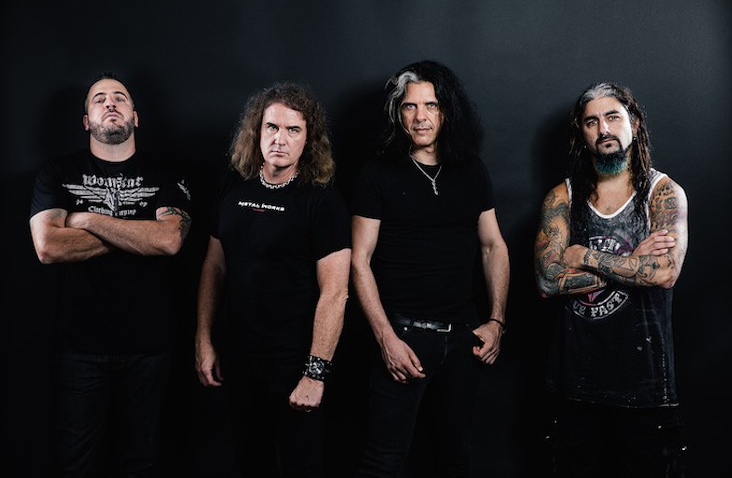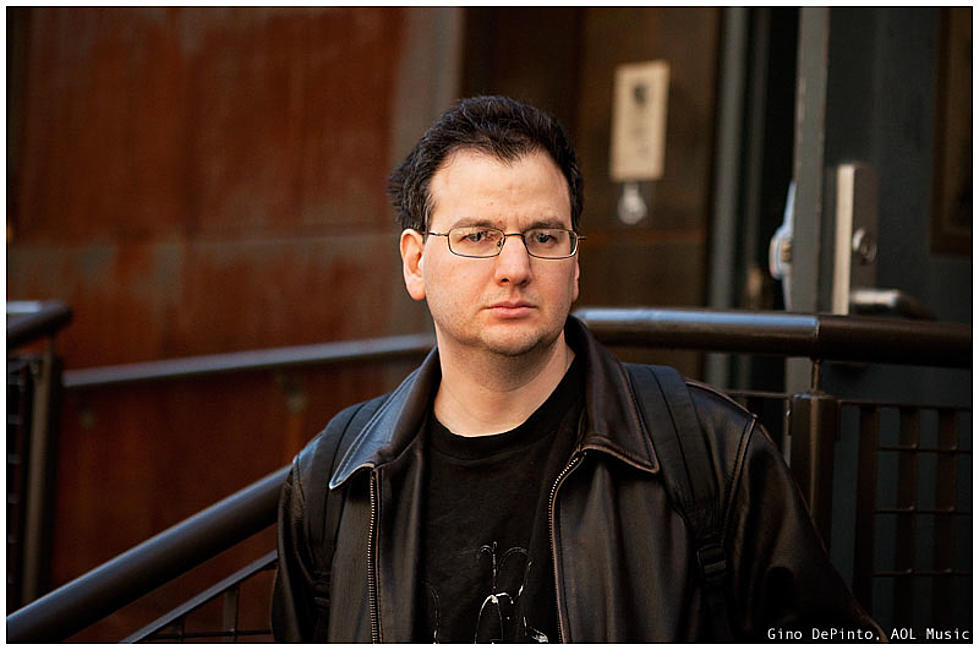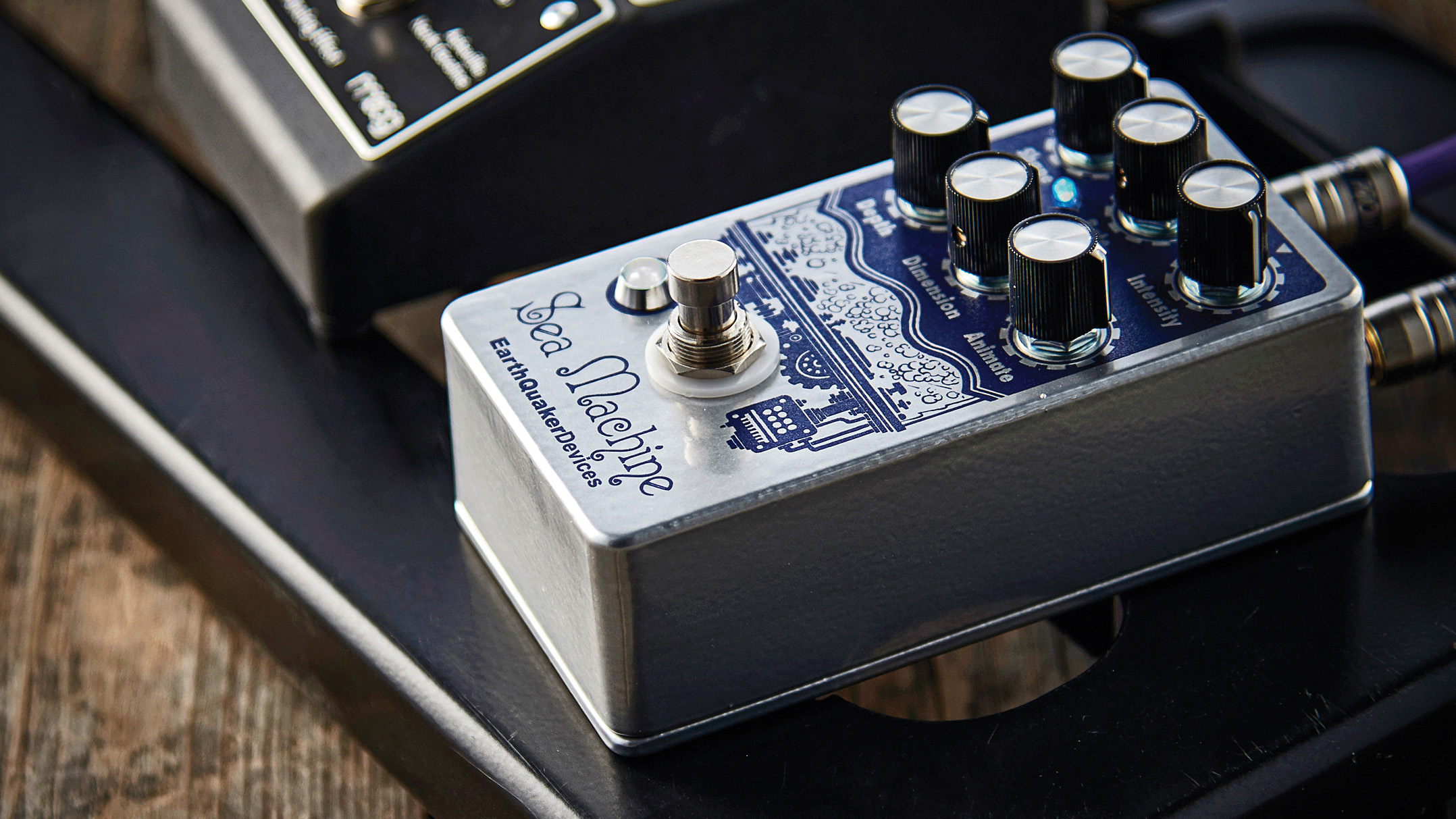Alex Skolnick and Dave Ellefson Talk Metal Allegiance, Premiere "Can't Kill the Devil" Playthrough Video

“This is like a musician fishing trip,” says Megadeth bassist Dave Ellefson on the final day of the Winery Dogs Camp.
Ellefson and Testament guitarist Alex Skolnick were hired as guest instructors for the event, now in its second year.
Prior to coming out, the two prepared lessons for students of various skill levels, and between classes everyone hung out with camp CEO Mike Portnoy and his Winery Dogs bandmates, vocalist and guitarist Richie Kotzen and bassist Billy Sheehan.
As much as recruiting Skolnick and Ellefson was a great way to get some thrash veterans to diversify the curriculum, it provided the perfect live testing ground for the musicians’ supergroup with Portnoy, Metal Allegiance.
While the three rockers and their business coordinator/songwriter Mark Menghi form the core of the band, there were numerous guest vocalists and guitarists on its self-titled debut album, and Metal Allegiance have signed up a string of understudies to fill in at a moment’s notice, should any of the main members find themselves on tour with their other bands.
“There’s already one show booked where three of us won’t be able to make it,” says Skolnick over a Skype line he’s sharing with Ellefson. “But the cool thing is the original four of us get to decide on our own subs.”
Late last year, Skolnick and Ellefson convened at Portnoy’s home studio in remote Coopersburg, Pennsylvania, and wrote all of the songs for Metal Allegiance’s self-titled first album. A jubilant celebration of metal from the early Seventies to the present, the record includes doom, prog, New Wave of British Heavy Metal, alt-metal, New American Metal and a whole lotta thrash, from classic to contemporary.
All the latest guitar news, interviews, lessons, reviews, deals and more, direct to your inbox!
Performing on the third campfire jam night as the Metal Allegiance Trio, the band’s classic metal and thrash covers set is capped by an instrumental version of the Metal Allegiance song “Can’t Kill the Devil,” a barreling, full-fisted number that normally features Testament vocalist Chucky Billy.
“It was the first time we ever played that song onstage and it was frickin’ rocking,” Ellefson exclaims, beaming like a kid who has just learned the solo to “Crazy Train.” “Even without the vocals it was awesome. Spread your knees, start headbanging and downpicking.”
That type of spirit epitomizes Metal Allegiance, a band empowered by the sheer love for metal to write and play songs in the style of some of their favorite bands. “Can’t Kill the Devil” is naturally reminiscent of the riff and vocal structures of Testament. On a parallel path, “Let Darkness Fall,” which features vocals by Mastodon’s Troy Sanders, is epic and psychedelic; “Gift of Pain,” helmed by Lamb of God’s Randy Blythe, could have been an outtake from VII: Sturm Und Drang; and the Phil Anselmo vehicle “Dying Song” sounds like Down performing Pantera’s “Cemetery Gates.”
“We wanted to wear our influences on our sleeves, only without being too derivative,” Skolnick says. “We were happy to write songs that had the vibe of other bands, whether it was Sabbath sludge, Iron Maiden harmonies or driving Priest-type rhythms.”
Metal Allegiance wrote their eponymous album during two one-week sessions in the winter of 2015. Some numbers, like “Pledge of Allegiance” and “Scars,” were as simple and comfortable as a well-worn pair of Converse, while the angular Iron-Maiden-Meets-Rush instrumental “Triangulum – I. Creation, II. Evolution, III. Destruction” and the Shinedown-crossed-with-Slayer maleficence of “Wait Until Tomorrow” were more challenging. “Every day we woke up with a mission,” says Skolnick. “Dave and I would grab our coffee, pick up our instruments and start bouncing ideas off one another.”
Once Metal Allegiance had a batch of songs ready, they put together a dream list of guest soloists and singers, and Skolnick took on the role of executive producer, working with the vocalists and guitarists to create passages that complimented the songs. The result is a collaboration album that sounds neither rushed nor cobbled together from recycled riffs. Leads from Holt (Exodus), Charlie Benante (Anthrax), Andreas Kisser (Sepultura), Phil Demmel (Machine Head), Ben Weinman (Dillinger Escape Plan) and Misha Mansoor (Periphery), don’t just fill space, they enhance the songs, as do vocals by Blythe, Sanders, Anselmo, Osegueda, Matt Heafy (Trivium), Jamey Jasta (Hatebreed) Cristina Scabbia (Lacuna Coil) and others.
A couple hours before checking out of Winery Dogs Camp, Skolnick and Ellefson explain the history of Metal Allegiance, discuss their own metal backgrounds and share some poignant moments they experienced with Dave Mustaine, Pantera and Taylor Swift’s backing band.
GUITAR WORLD: What was the first metal band to make an impression on you?
DAVE ELLEFSON The definitive metal record for me was Judas Priest’s Unleashed in the East. I was 15 years old. It looked dangerous, it felt scary. I turned it down when my parents were in the room and I turned it up when they left, which is always a pretty good qualifier. If your parents hate it, it’s probably awesome.
ALEX SKOLNICK I found a used British punk rock compilation album featuring bands like Generation X. But for some reason the record also had a song by Motörhead. I noticed they sounded completely different from all the others and I liked the power and intensity of it.
Motörhead were the one of the most important—if not the most important—bands for the development of thrash.
SKOLNICK I liked them, but then I heard Accept’s “Fast as a Shark.” And I think that one song had more impact on thrash metal than many songs by bands more aligned with the scene. “Fast as a Shark” influenced everybody. Until I heard that song, I didn’t realize you could play something with Motörhead’s energy and the virtuosic guitar work of Randy Rhoads. Then when I started going to club shows in the Bay Area I discovered Exodus, who played out a lot, and were even heavier. One night they had a band on the bill called Slayer. They did what Motörhead did, but it was darker. The San Francisco gig they did with Exodus was legendary. Slayer had makeup on, and Gary Holt said, “You guys are awesome, but the makeup’s gotta go.” The next time they came through town they were more like the Slayer we know today.
Did you see Exodus and Slayer before you heard Metallica?
SKOLNICK Yes. Metallica was just another one of these bands. I had heard their name, but there were so many groups around at the time. The first time I saw them was on the Kill ’Em All tour at The Stone, and I thought, Wow, this band must be a big deal because this is the most crowded I have ever seen this place.
Dave, what was your first exposure to thrash?
ELLEFSON When I first met Dave Mustaine in L.A. in June 1983, two months after Metallica parted ways with him. He lived right up above me. We met and started Megadeth later that month. The defining moment came when he played me Metallica’s No Life Til Leather demo that he was on.
Everyone from Gene Simmons to Lemmy says they started playing in a band to score chicks. Did you share that motivation?
ELLEFSON I was too young to know about girls. I got my bass at 11. Girls scared me. I think my first girlfriend broke up with me in sixth grade because I wouldn’t kiss her. Fast forward a little bit, and I did notice as a teenager that when girls started coming into their own and blossoming they instinctively gravitated toward the danger of rock and roll and musicians—not all girls, but the bad girls, for sure. And then I started to believe that sometimes the best girl is the bad girl. So my eyes got opened to that and there were certainly plenty of bad girls around in the early days. But eventually you realize that tomorrow when you’re gone they’ll find other guys in other bands. That’s when you re-evaluate what you’re doing and who you’re doing it with.
SKOLNICK I was really young too when I started playing. I was 10 years old and very introverted. Even if girls were around I couldn’t talk to them. I was literally in my twenties before I could have a functional conversation with a pretty female. I was never into the groupie thing. I pretty much kept to myself.
The roots of Metal Allegiance date back to April 2011 at Sam Ash Music when many musicians were in California for the first U.S. Big 4 concert.
ELLEFSON Back then the band was called Metal Masters. Mark Menghi used to work at Hartke/Sampson and he said to me, “I want you and [Anthrax bassist] Frank Bello to do some clinics together.” Then Mark said, “Let’s bring in Charlie Benante and Mike Portnoy before the Indio Big 4 show and everyone can jam.” That was the first Metal Masters. It’s nice that Charlie plays guitar, and that’s why we made sure he played guitar on the record. From there, we did shows on an annual basis. Then in July of last year Mark called me up and said, “I was just talking to Portnoy about some future plans.” And I said, “Dude, the one thing we shouldn’t let go of is Metal Masters.” Two days later Mark called me back and said, “I just trademarked the name Metal Allegiance. We’re ready to go.” Suddenly, Megadeth pulled off the Motörboat cruise [because Dave Mustaine needed time to recover from back surgery] and since all these musicians were going to be on the boat anyway, I said, “Look, if we can put a Metal Allegiance show together, we can have a fun event that metal fans can enjoy.” Alex, you played a huge role in creating the Metal Allegiance album but you were actually a latecomer to the project.SKOLNICK I’m still sort of taking it in. I knew about Metal Masters, but I was always out of town when they played so I was never able to be part of the shows until Motörboat, which was less than a year ago. The whole thing is a happy accident. ELLEFSON The second night of the cruise we wanted to change up the set and Alex was sitting about two feet away from me. Someone said, “Hey dude, we don’t want to leave you out. You wanna join in?” We basically did side one of Van Halen. It was me, Alex, Portnoy and Bello, Benante and Scott Ian from Anthrax. We walked up and just winged it. The response from fans was, “God, it’s fun to see you guys being fans, too.” A couple songs on Metal Allegiance recall Pantera, who held the metal torch aloft throughout the Nineties. When did you first meet them?ELLEFSON It was 1988. A girl I was going out with at the time was from Dallas and she introduced us. We went out drinking. And right as we were getting ready to wrap it up for the night, Dime stops, looks me in the eye and says, “Dude, I just want to tell you Peace Sells changed my life.” I still get goosebumps thinking about that. The next night they played this bar and did half covers and half originals. And they had me come up onstage with them and play “Peace Sells.” Fast-forward a few months; we were looking for a guitarist and I said to Dave, “What about Diamond Darrell.” So Dave reached out to Dime and Dime says, “Look, with me comes my brother Vinnie. We’re a team.” Chuck Behler was our drummer at the time and we weren’t looking to replace him. So that didn’t work out. But that’s fine because we did great and look what happened to Pantera.SKOLNICK I saw them at that same club around the same time. Testament were making our second record and we heard about this local band. They were very familiar with us and knew all our songs. We jammed with them and it was a lot of fun. A couple years later I was listening to the radio and I went, “Hey, that sounds like that bar band that was really good.” The rest is history.ELLEFSON For Dime to tell me Peace Sells changed his life, that’s a perfect example of a musician being influenced by Megadeth and then going on and doing his own thing that didn’t sound like a Megadeth rip-off. SKOLNICK I experienced that with Lamb of God. I wrote a lot of the single-note stuff for Testament, like “Into the Pit.” Lamb of God took the riff from “Into the Pit” and did their own thing with it [on “Laid to Rest.”] I can hear the influence, but what they did is so different and I love it.ELLEFSON Some say imitation is the greatest form of flattery. To me the greatest form of flattery is when somebody is influenced by our music and then they go and do something completely different with it. I met these musicians in church who play liturgical songs, and they told me they grew up on Megadeth and Metallica. I was blown away.SKOLNICK At this last NAMM show I had two very clean-cut guys who looked like they could be in a men’s catalog come up to me and say, “Can we get pictures with you? We’re huge fans.” I said, “Sure, what do you guys do?” And they said, “Oh, we play for Taylor Swift.” They were her guitarist and bassist.Did you know from the start that Metal Allegiance would have a great writing chemistry?ELLEFSON We didn’t have any idea what it was going to be like because none of us had ever written together before. We had a prog dude, an uber-shred dude and a thrash metal bass dude and Mark Menghi, who was the first one to light us up if we deviated from all things metal. SKOLNICK It was cool because we turned all these ideas we came up with into real songs that we love. There are all these guys online writing in the gutter of the comment section of metal web sites: “This is gonna suck. These guys don’t know how to write songs.” No, we actually do. You have no idea what you’re talking about and you’re about to find out.ELLEFSON We pushed out “You Can’t Kill the Devil” to get some excitement brewing for the record. And when that got out there a lot of the haters got real quiet. You are all still in other bands. Does that make it difficult to book gigs for Metal Allegiance?ELLEFSON One thing we decided early on is that no one can cling to Metal Allegiance as their band. Metal Allegiance is designed to bring the metal community together. And when people start to get too invested in leaving their claw marks on stuff things sometimes get destroyed. Our whole philosophy is hold on loose and enjoy the ride and be a part of it when you can. If you can’t, don’t sweat it. We’ve got a sub. We’re two and three deep on the bench in every position. Metal Allegiance is greater than the sum of its parts. And I think that’s how it will continue to grow.Metal Allegiance AxologyALEX SKOLNICK
GUITARS ESP Alex Skolnick in Silver Sunburst, Gibson Les Paul 1960 Gold Top
PICKUPS Seymour Duncan Custom Pickups
STRINGS D'Addario NYXL .011–.052
PICKS Dunlop
AMPS Budda Amplification AS Preceptor, '68 Marshall Plexi
EFFECTS ToneConcepts Distillery, Jam Pedals TubeDreamer 88DAVE ELLEFSON
BASSES Modulus Quantum 5 with EMG pickups, early Nineties Fender Precision Bass with rosewood fingerboard and EMG PJ pickups, ESP four-string bass with maple fingerboard
STRINGS SIT Power Wound Nickel
PICKS Dunlop Tortex .88
AMPS Ampeg B15 flip-top with 15-inch speaker
EFFECTS Morley Wah pedal, Peterson and Planet Waves bass tuners
Jon is an author, journalist, and podcaster who recently wrote and hosted the first 12-episode season of the acclaimed Backstaged: The Devil in Metal, an exclusive from Diversion Podcasts/iHeart. He is also the primary author of the popular Louder Than Hell: The Definitive Oral History of Metal and the sole author of Raising Hell: Backstage Tales From the Lives of Metal Legends. In addition, he co-wrote I'm the Man: The Story of That Guy From Anthrax (with Scott Ian), Ministry: The Lost Gospels According to Al Jourgensen (with Al Jourgensen), and My Riot: Agnostic Front, Grit, Guts & Glory (with Roger Miret). Wiederhorn has worked on staff as an associate editor for Rolling Stone, Executive Editor of Guitar Magazine, and senior writer for MTV News. His work has also appeared in Spin, Entertainment Weekly, Yahoo.com, Revolver, Inked, Loudwire.com and other publications and websites.

